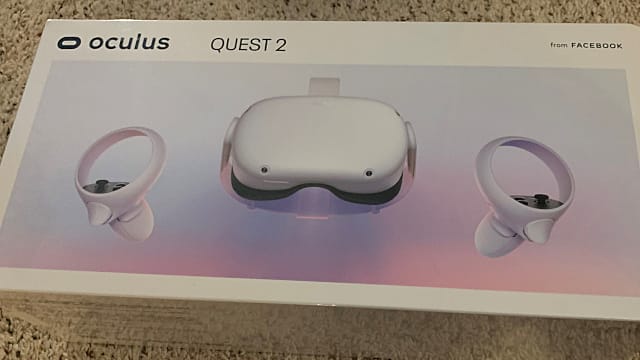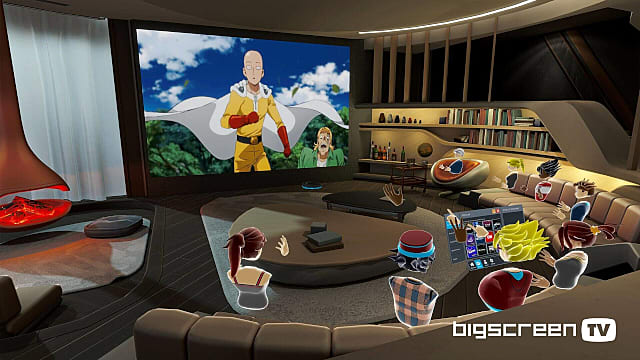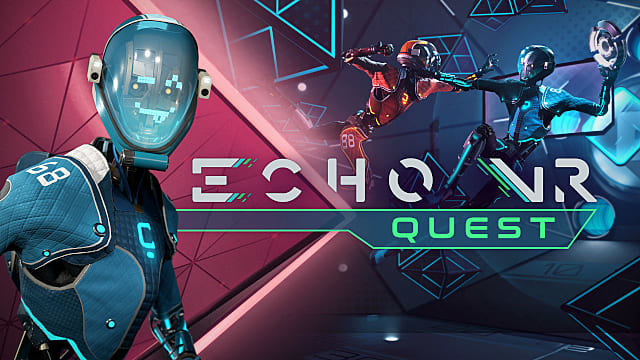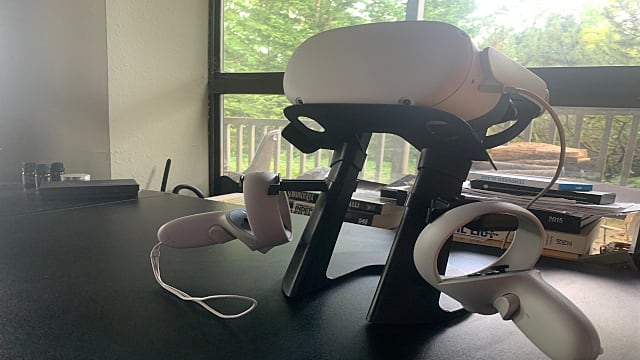

I've been a VR fan for three years.
After I got my first fix, way back in 2017 with the Oculus Rift's First Contact app, I knew I was in love. VR quickly grew into a well-worn escape route when everything else in the world was too much to bear.
I followed the Oculus Quest launch and purchased one when it was first released. Then I owned a Rift S, which was better than the original Oculus Rift in resolution and comfort but was still chained to the computer.
And now here I am, sitting in my writing chair with a brand new Oculus Quest 2 in my lap. Feature-wise, Facebook's second crack at fully-wireless VR is, without a doubt, the best virtual reality product I've ever owned.
However — and this is a big "however" — I can't recommend the Quest 2's sleek new design, vastly improved resolution, and souped-up framerates without also addressing Facebook's troubling new policy in the wake of its launch.
Read on to find out what the Oculus Quest 2 improves over its forebears, and why that pesky attachment to Facebook can potentially be a dealbreaker.
Oculus Quest 2 Review: Big Improvements, One Big Drawback

Initial Thoughts
Between the smaller and cozier layout, almost-4K per-eye visuals, adjustable refresh rate, improved controller and hand tracking, and an immensely more powerful XR2 processor, there's quite a lot to enjoy about the new Oculus Quest 2.
Those who don't already own an Oculus Quest are in for a treat. The Quest 2's base 64GB model, priced at $299, is the most affordable wireless 6DoF VR headset — a wireless, computer-less VR headset that includes hand-tracked controllers and head tracking — that we've ever seen.
Likewise, with the Quest 2 boasting "twice as much" processing power and visual capabilities as the original Oculus Quest, it's fair to assume that game sizes will ultimately increase. This is why it's great that Facebook has offered a 256GB model of the Oculus Quest 2 for $399, the same price that owners of the original 64GB Oculus Quest, Oculus Rift CV1, and Oculus Rift S each paid for their devices.

And much like the original Quest, the Quest 2 is also completely wireless by default. It can still hook into an optional gaming PC via USB-C, from which you can still play any PC VR games you own either on Steam or in the Oculus Rift library.
Of course, the necessary cable to do so comfortably — the Oculus Link cable sold directly by Facebook — is an added purchase, which is a bummer. However, as of this review, you still have the freedom to tap into your Wi-Fi connection and wirelessly link into a gaming PC using Virtual Desktop.
In fact, wireless is the most enjoyable way to play those great PC VR games like Half-Life: Alyx and Asgard's Wrath.
Connectivity
Wi-Fi 6 is included in the package this time around, making downloads and streaming much smoother and more accessible. I haven't tried wirelessly streaming games from Virtual Desktop on the Oculus Quest 2, but in theory, its inclusion of Wi-Fi 6 on a 60GHz antenna should make a dent.
This poses a much better solution for wireless PC VR gaming and media consumption than the Wi-Fi 5 band that was built into the first-generation Oculus Quest.
Graphics
The Quest 2's LCD display resolution of 1832 x 1920 per eye makes games, video content, and text appear crisper and more lifelike than they ever have before in an Oculus headset.
Facebook claims that the Quest 2 boasts a 50% increase in pixel density over the previous Oculus Quest, which has a resolution of 1440 x 1600 per eye, and it certainly shows.
There's a clear improvement in quality and sharpness that makes sitting down in front of a virtual movie theatre in BigScreen or exploring the solar system in Titans of Space that much more engrossing and believable. Though god rays remain an issue, the screen door effect is finally gone.
It's actually surprising just how far we've come from the original 1080 x 1200 resolution of the Oculus Rift CV1 and HTC Vive. Re-experiencing the content you enjoyed on those headsets would feel like a true "next-gen" experience on the Quest 2.

Of course, the sweetest part of the deal is the inclusion of a new "experimental" 90hz mode. For context, 90hz was once considered the "gold standard" of VR refresh rates. In comparison, the original Oculus Rift CV1 ran at a steady 90hz, but the Oculus Quest only ran at 72hz or 60hz, depending on the mode.
This mixes the best of both worlds, erasing the concessions that needed to be made to get the first-generation Quest to work. In doing so, Quest 2 makes good on the original Quest's promise of offering "PC-quality VR."
Controllers and Tracking
I love to work out in VR, using games like FitXR and The Thrill of the Fight to get my fitness boxing and shadowboxing in. However, my Oculus Quest controllers would lose their position if I swung too fast or too hard.
One of the subtle improvements over the first-gen Quest is how much better the Quest 2's Touch controllers seem to be at accurately pinpointing my hand placement during high-intensity maneuvers. No longer do I have to watch my fist fly out 20 meters in front of me when I'm going for the knockout punch.
I assume that this is due to improvements in the Quest 2's camera and tracking system in general. Whereas the original Quest offered an experimental hand-tracking mode that was temperamental and difficult to control, the same mode in Quest 2 seems to pick up and recognize the precise movements of my hands and fingers for longer.
Comfort
For those who really struggled with discomfort when wearing the original Oculus Quest for too long, Quest 2 solves that problem. Sort of. The smaller dome indeed makes it easier for the headset to fit comfortably on your face without being too front-heavy, but there are some tradeoffs here.
Instead of an IPD (interpupillary distance) slider, there is now an adjustable bracket that only comes in three settings. Unless your IPD is 58, 63, or 68, you'll find yourself faffing about with these three settings until you figure out which one looks good enough. However, you can't adjust the bracket while your face is inside of the headset, so the whole process is just annoying.
The adjustable head strap that comes out of the box is finicky and weird, and it certainly doesn't feel like a good replacement for the strap design used in the Oculus Quest and Rift CV1.
That said, I reviewed the Quest 2 with the Elite Strap, which mimics the best feature of the halo-ring strap design of the Rift S: there's a dial that tightens and loosens the Quest 2 fit around your head, and it makes the process of putting the thing on so much less tedious than it would be otherwise.

Audio
As usual, there are built-in audio speakers that sit inside of the strap mounts. If you've worn a portable Oculus headset or a Rift S, you already know that these in-strap speakers pale in comparison to the quality of proper headphones.
But I noticed that the sound was slightly more robust in the Oculus Quest 2 straps, with absolutely no crackling at the highest volume level, something that was a prominent issue on my original Oculus Quest.
Battery Life
The battery life is effectively the same in the Oculus Quest 2 as it was in the first-generation Quest. Assuming you treat the battery well, it should give you about two hours of use per charge, even when you play games that push the Quest 2's bells and whistles.
The Facebook Dilemma
Finally, the major drawback of the Quest 2: Facebook's direct involvement, which has become more and more anti-competitive and intrusive. Now that Oculus accounts and Facebook accounts are effectively the same thing, Facebook requires new Oculus users to turn over their Facebook account information or get the boot.
This may seem like no big deal, but it's already led to users being inexplicably banned from their Oculus headsets and content libraries. Since Oculus is all digital, your content library is entirely in the hands of Facebook, who has the right to discontinue your access to your Oculus Quest 2 and everything you own inside of it.
That also applies to users who delete their associated Facebook account or get banned somehow. A suspension on the social media site could also imply loss of access to your Oculus Quest 2. Because of how stringent Facebook has become with its user agreement, it's unlikely that using a "burner" account will be a winning strategy down the line.
The Good News
Being in Facebook's system doesn't mean you're stuck with games and apps exclusively from the Oculus catalog. Many Oculus Quest owners have used a method called "Sideloading" to gain access to unofficial games and Virtual Desktop.
So far, any fear of Facebook squashing this method has been unfounded. Once you're plugged into your Facebook account, you're still given the same amount of agency to do the same things you could do before — just as long as you aren't caught breaking Facebook's terms of service.
Oculus Quest 2 Review—The Bottom Line

Pros
- Completely wireless VR
- Most affordable VR on the market
- Wildly improved visuals and performance from its predecessor
- More comfortable than its predecessor
Cons
- Still not as comfortable as I'd like
- New dependency on Facebook accounts worrying
As a longtime fan of Oculus headsets, I'm thoroughly enjoying my time in the Quest 2. It's clear that the Oculus Quest 2 is the highest-quality piece of VR hardware that Facebook has produced thus far.
Unfortunately, if you're opposed to Facebook's practices, it may be hard — if not impossible, Facebook account status pending — to appreciate the Oculus Quest 2 at all.
[Note: Facebook provided the Oculus Quest 2 unit used for this review.]
0 comments:
Post a Comment